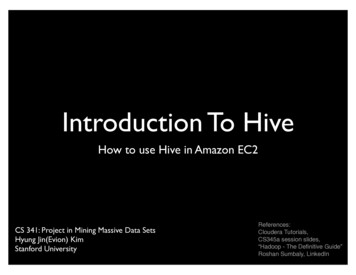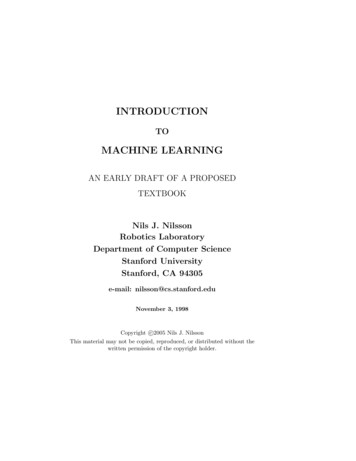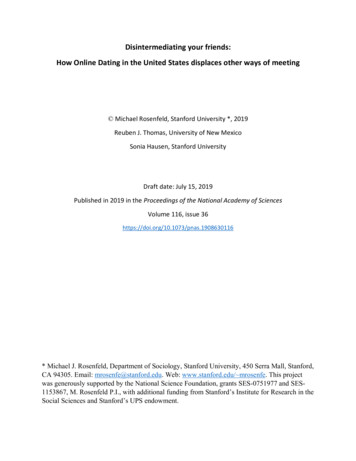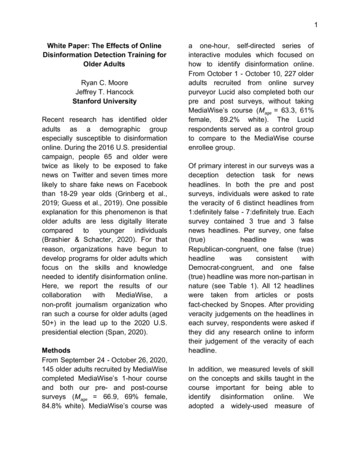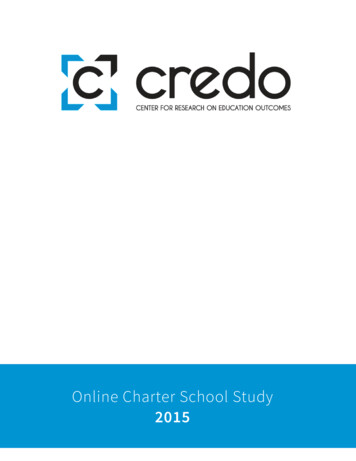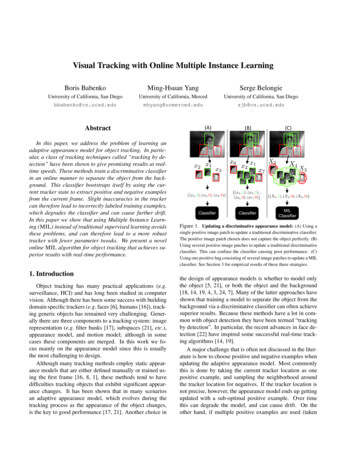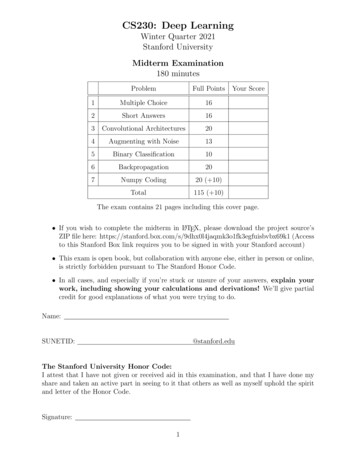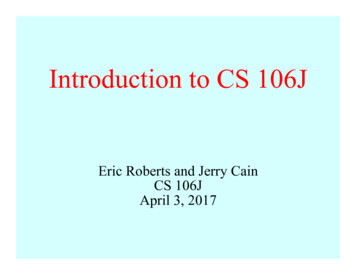
Transcription
Introduction to CS 106JEric Roberts and Jerry CainCS 106JApril 3, 2017
Course DescriptionCS 106J: Programming Methodology in JavaScriptIntroduction to the engineering of computer applications emphasizingmodern software engineering principles: object-oriented design,decomposition, encapsulation, abstraction, and testing. Emphasis is ongood programming style. This course covers the same material as CS106A but does so using JavaScript, the most common language forimplementing interactive web pages, instead of Java. No priorprogramming experience required. Enrollment limited to 100.Terms: Spr Units: 3-5 UG Reqs: WAY-FR Grading: Letter or CR/NCCS 106J covers the same material and meets the sameWAYS requirements as any other CS 106A section.
Why JavaScript? When Stanford adopted Java a little over a decade ago, weexpected—along with its designers—that it would become the“language of the web.” That didn’t happen. Today, the “language of the web” is JavaScript, which hasbecome the most widely used language in industry. Along with JavaScript expert Douglas Crockford, we believethat, as long as you avoid some of its most commonly abusedfeatures, JavaScript is “a beautiful, elegant, highly expressivelanguage” that is ideal for a first course in programming.––––It is considerably easier to learn than Java.There are far fewer confusing details to memorize.It offers much cleaner implementations of modern features.It is universally supported on the web.
JavaScript is the Most Popular Language
Why Study Computer Science?Sources: National Center for Education Statistics 2014; Bureau of Labor Statistics 2014-2024 projections.We are very happy with the students that we get from thisuniversity. . . . We just wish we could hire two to threetimes as many of them.— Bill Gates at Stanford, February 19, 2008
Everyone Needs Some ProgrammingHalf of all jobs in the top income quartile value coding skills.Source: Burning Glass Technologies, “Beyond Point and Click: The Expanding Demand for Coding Skills,” June 2016.
CS 106J Course StaffEric Robertseroberts@cs.stanford.eduOffice Hours (Gates 202):Tuesdays 9:30–11:00Jerry Cainjerry@cs.stanford.eduOffice Hours (Gates 192):Wednesdays: 3:30–5:00Jason Chencheson@stanford.eduOffice Hours (TBA):TBA
Syllabus—Week 1April 3AdministrationCourse overviewMeet Karel the Robot57Simple Karel programsControl structures in KarelRead: Sections 1.1-1.3Problem-solving in KarelProgram decompositionThe idea of an algorithmRead: Sections 1.4-1.5
Syllabus—Week 210Programming by exampleVariables and valuesArithmetic expressionsFunctionsRead: Sections 2.1-2.412Strings and concatenationSimple graphicsRead: Sections 2.5-2.614Control statementsBoolean dataRead: Sections 3,1-3.5
Syllabus—Week 317Arguments and parametersLibrariesRandom numbersRead: Sections 4.1-4.2Due: HW #1 (Karel)19The mechanics of functionsDecompositionRead: Sections 4.3-4.4Due: Karel contest21First-class functionsEvent-driven programmingResponding to mouse eventsRead: Sections 5.1-5.4
Syllabus—Week 42426Simple animationTimersRead: Section 5.5Due: HW #2 (Simple JS)28The GArc classThe GPolygon classThe GCompound classRead: Section 5.6Binary representationRepresenting charactersRead: Section 6.1
Syllabus—Week 5May 1JavaScript’s String classCommon string patternsRead: Sections 6.2-6.33Problem solving with stringsString applicationsRead: Section 6.45CryptographyThe GLabel classRead: Section 6.5Due: HW #3 (Breakout)
Syllabus—Week 6810Debugging strategies12Simple arrays and filesUsing arrays for tabulationMidterm ExamTuesday, May 93:30 P.M. or 7:00 P.M.Due: Graphics contestRead: Sections 7.1-7.2Read: Section 7.3
Syllabus—Week 71517Multidimensional arraysPixel arraysThe GImage classRead: Sections 7.4-7.5Due: HW #4 (HangKarel)19Objects as aggregatesRead: Sections 8.1-8.2JavaScript and OOPLibraries and interfacesDefining classes and methodsRead: Sections 8.3-8.5
Syllabus—Week 82224Objects as mapsRead: Section 8.6Large-scale data structuresData-driven programsRead: Section 8.726Overview of Adventure!Read: Adventure handoutDue: HW #5 (Yahtzee)
Syllabus—Week 92931Memorial DayJune 2JavaScript and the webUsing web interactorsRead: (handouts for the day)Read: (handouts for the day)(no class)
Dead Week and Beyond57Looking aheadFrontiers of computing(optional)Read: (handouts for the day)Due: HW #6 (Adventure)Due: Adventure contestReview session:Monday, June 127:00-9:00 P.M.Final exam:Wednesday, June 148:30-11:30 A.M.
Assignments in CS 106J Assignments in CS 106J are due at 5:00P.M. Assignments thatcome in after 5:00 will be considered late. Everyone in CS 106J starts the quarter with two “late days”that you can use at any time you need some extra time. In mycourses, late days correspond to class meetings, so that, if anassignment is due on Wednesday and you turn it in on Friday,that counts as one late day. Extensions can be approved only by the TA, Jason Chen. Assignments are graded by your section leader, who discussesyour work in an interactive, one-on-one grading session. Each assignment is given two grades: one on functionality andone on programming style. Style matters. Companies inSilicon Valley expect Stanford graduates to understand howto write code that other programmers can maintain.
The CS 106J Grading Scale Functionality and style grades for the assignments use thefollowing scale:A submission so good it “makes you weep.”Exceeds requirements.Satisfies all requirements of the assignment.Meets most requirements, but with some problems.Some more serious problems.Even worse than that.Why did you turn this in?
Contests CS 106J will have three contests as follows:– The Karel Contest associated with Assignment #1– The Graphics Contest associated with Assignment #3– The Adventure Contest associated with Assignment #6 First prize in the contest is a score of 100% on one of thegraded components of the course, typically the final exam. As an additional incentive, entering any of the contests givesyou a virtual ticket to win an additional grand prize in arandom drawing at the end of the quarter. So does receiving arunner-up or honorable mention on a contest and findingerrors in the text and tools. Entering a contest also earns “house points” for your class inthe style of the Hogwarts School from Harry Potter.
Honor Code RulesRule 1: You must not look at solutions or program code that isnot your own.Rule 2: You must not share your solution code with otherstudents.Rule 3: You must indicate on your submission any assistanceyou received.
Meet Karel the Robot obotisunderstandsobjectssurroundedcomposedwas developedthat whichtheoveraremove.southwestsmall30 ttheinthenproblem,Manhattan,emitKarela ple,runof106Jthenorth-south.)worldI’ve thataddedblock“gentleIna oatheleftst Streetndstprogrammingfacingof1pickBeeper()east rentAvenue.Pick ofup a1solving.beeperfromsquareputBeeper()Put down a beeper on the current square3 2 1 12345
Your First Challenge How would you program Karel to pick up the beeper andtransport it to the top of the ledge? Karel should drop thebeeper at the corner of 2nd Street and 4th Avenue and thencontinue one more corner to the east, ending up on 5th Avenue.3 2 1 12345
The End
Read: Sections 8.1-8.2 19 JavaScript and OOP Libraries and interfaces Defining classes and methods Read: Sections 7.4-7.5 Read: Sections 8.3-8.5 15 Multidimensional ar
